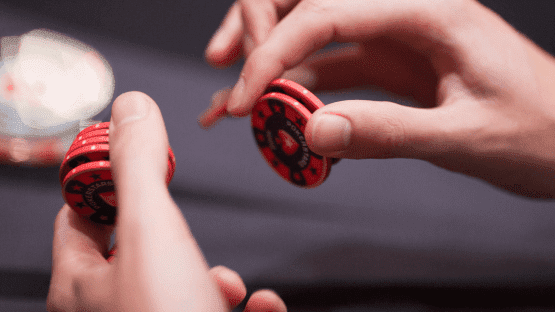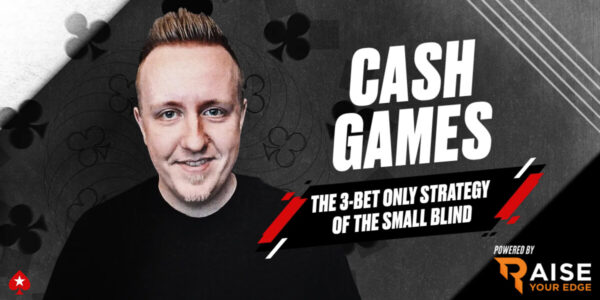6-Max Cash Poker – Dealing with C-Bets
We have already studied selective and unselective c-bet strategies in this series as well as how to defend our blinds against open raises. Now it is time to complete the picture by learning what to do as the defender when we face a c-bet on the flop, having called a pre-flop open. We shall begin by addressing the main three reasons for calling c-bets before moving on to design some raising strategies against the two types of c-bet strategy that we looked at in Part 4.
Reason 1 – Calling for Showdown Value
Showdown value generally signifies a strong enough holding to call a bet, but probably nothing strong enough to build a giant pot with. Showdown value hands are typically doing fine against Villain’s betting range, but would suffer against the range with which Villain might call a raise. Therefore, showdown value tends to go hand in hand with the call button and not the raising slider. Let’s take an example:
Holding KQo in the BB, we decide to just call the SB’s 3bb open. Of course 3-betting would also be a viable path, but there is nothing wrong with mixing a strong but non-premium hand such as this one between both actions. Without a read, there is little difference in EV between the two lines.
The flop comes down AQ4tt and Villain bets half of the pot. Getting 3:1 is more than good enough to continue with this hand. Of course Villain will sometimes hold top pair and crush us, but overall, our hand will get to showdown and win often enough to make this investment profitable. We do not desire any fold equity as the only hands we would commonly fold out by raising would be far behind us any way and we would rather not donate extra money to our opponent’s top pair and better when he has it.
Reason 2 – Calling for Implied Odds
Implied odds are less about what is in the middle now and more about what could be later. As we learned previously, implied odds are a ratio of money invested to money gained on average in the event of making a big hand. Comparing this ratio to how often we make said big hand tells us how favourable our implied odds are and whether or not it is worth calling the bet in question. Generally, there will be an inverse relationship between our implied odds and our fold equity. Implied odds mean getting paid off on a regular basis if our draw comes in and getting paid off on a regular basis means that Villain will not be prepared to fold very often to future aggression on our part.
For example, Villain is a very aggressive and combative player who has recently taken a beating and is eager to enact revenge on the nearest opponent. He opens UTG for 3bb and we call on the button with 7s6s, a fine hand with which to roll the dice and expect a handsome reward should the dream flop come down. The flop is not quite what we were yearning for, but does offer some hope. We look down at 842r and Villain fires a two-thirds pot sized bet. We are 100bb deep. Our hand is not getting close to the required direct pot odds to continue, nor do we expect to bully this crazed maniac off of much of his range later on, but that is precisely why we call. If we are lucky enough to get there on the turn, the payout promises to be enormous on a very regular basis. We will gladly lose 3.5bb 10 times in order to win 50 or 60bb on average when our gutshot draw completes.

Floating
Floating is all about calling a non-made hand vs. a c-bet because while implied odds are low, future fold equity is promising. Let’s say we flat a SB 2.5bb open in the BB with Jh7h and the flop comes 9d8h4d. Villain fires a small bet and we consider our options. Most players at the lower limits are guilty of c-betting a little more freely than they should and not following this up with too much later street aggression. On average then, we shall do very well by calling and waiting for our moment to take the pot away later. This will not always transpire, but in the event that Villain does have a real hand or decides to continue to apply pressure without one, we have our overcard, gutshot and backdoor flush draw to fall back on. We call here not to simply chase our draw, but to combine our chances to win, future fold equity being an essential piece of the puzzle.
A Word on Raising C-Bets
Picking a raising strategy against a c-bet is all about estimating the nature of the c-bettor’s range. If we face a small bet from a regular on a dry board we can assume that Villain is normally c-betting unselectively with a very wide and mixed assortment of hands. Let’s say that we called a BU open from the BB and check to face a one-third pot c-bet on 7s2d2c. Even a humble pair like 66 is now a fairly big hand relative to Villain’s wide range. Moreover we are incentivized to raise with it in order to deny equity to Villain. We do not want him to see the turn and the river for this minuscule bet – that would only enhance the performance of his small c-bet strategy. We want to apply a lot of pressure against a very wide small c-betting range and attack with hands that can extract clear value (A2o), bluffs which have some potential to improve (9c8c), and hands that need to deny equity like our 66.
If, however, we think that Villain is c-betting a more selective range consisting of strong value hands and draws (go back to Part 4 if this sounds unfamiliar) then we must attack in a much more polarized manner, mainly raising very good hands for value and higher equity bluffs to balance. In the same BB vs. BU spot on a flop of JhTh8d, if Villain makes a pot-sized bet, we certainly do not want to be raising with less than a set or top two pair. The difference here is that Villain’s likely selective betting strategy leaves no room for medium strength hands in his range and so if we were to raise with something marginal, it would simply isolate us against a range that crushes us.
Conclusion
Building sensible c-bet strategies is not just useful in and of itself, it also helps us learn how to defend against our opponents’ c-bets. If you are calling a c-bet, know why it is profitable to do so and if you are raising, make sure you have the right sort of range for the right situation.
Condimentum Nibh
Donec sed odio dui. Cras mattis consectetur purus sit amet fermentum. Vestibulum id ligula porta felis euismod semper. Curabitur blandit tempus porttitor.












